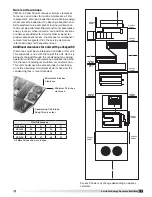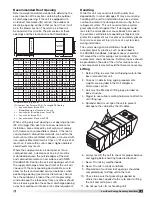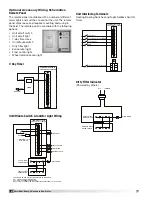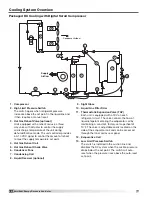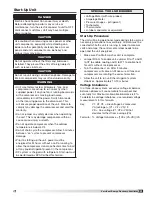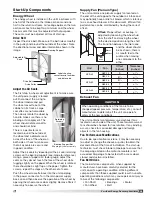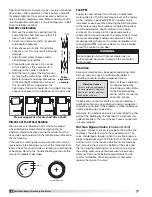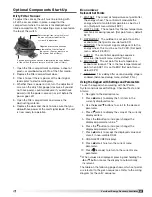
12
VersiVent Energy Recovery Ventilator
WARNING
The roof lining contains high voltage wiring. To prevent
electrocution, do not puncture the interior or exterior
panels of the roof.
WARNING
To prevent injury or death due to electrocution or
contact with moving parts, lock disconnect switch
open.
For units with a gas furnace, if you turn off the power
supply, turn off the gas.
IMPORTANT
Before connecting power to the unit, read and
understand the following instructions and wiring
diagrams. Complete wiring diagrams are attached on
the inside of the control center door(s).
IMPORTANT
All wiring should be done in accordance with the latest
edition of the National Electrical Code ANSI/NFPA 70
and any local codes that may apply. In Canada, wiring
should be done in accordance with the Canadian
Electrical Code.
IMPORTANT
The equipment must be properly grounded and
bonded. Any wiring running through the unit in the
airstream must be protected by metal conduit, metal
clad cable or raceways.
CAUTION
If replacement wire is required, it must have a
temperature rating of at least 105°C, except for an
energy cut-off or sensor lead wire which must be rated
to 150
°
C.
DANGER
High voltage electrical input is needed for this
equipment. This work should be performed by a
qualified electrician.
CAUTION
Any wiring deviations may result in personal injury or
property damage. Manufacturer is not responsible
for any damage to, or failure of the unit caused by
incorrect final wiring.
WARNING
If unit is equipped with a microprocessor, terminals Y1,
Y2 and W1 cannot be wired to a thermostat. Wiring to
these terminals will bypass unit’s internal safeties.
Electrical Installation
1. Determine the Size of the Main Power Lines
The unit’s nameplate states the voltage and the unit’s
MCA. The main power lines to the unit should be
sized accordingly. The nameplate is located on the
outside of the unit on the control panel side.
2. Determine the Size of Electric Heater Wiring
An optional electric heater may require a separate
power supply. The power connection should
be made to the factory-provided electric heater
disconnect and must be compatible with the ratings
on the nameplate, supply power voltage, phase and
amperage. Consult ANSI/NFPA 70 and CSA C22.1
for proper conductor sizing.
3. Provide the Opening(s) for the Electrical
Connections
Electrical openings vary by unit size and arrangement
and are field-supplied.
4. Connect the Power Supplies
Connect the main power lines and electric heater
power lines to the disconnect switches or terminal
blocks and main grounding lug(s). Torque field
connections to manufacturer’s recommendations.
5. Wire the Optional Convenience Outlet
The convenience outlet requires a separate 115V
power supply circuit. The circuit must include short
circuit protection which may need to be supplied by
others.
6. Connect Field-Wired Low Voltage Components
Most factory-supplied electrical components are
prewired. To determine what electrical accessories
require additional field-wiring, refer to the unit-
specific wiring diagram located on the inside of the
control center access door.
If unit is equipped with a microprocessor, terminals Y1,
Y2 and W1 cannot be wired to a thermostat. Wiring to
these terminals will bypass unit’s internal safeties.
Control wires should not be run inside the same conduit
as that carrying the supply power. Make sure that
field-supplied conduit does not interfere with access
panel operation. All low voltage wiring should be run in
conduit wherever it may be exposed to the weather.
The low voltage control circuit is 24 VAC and control
wiring should not exceed 0.75 ohms. If wire resistance
exceeds 0.75 ohms, an isolation relay should be added
to the unit control center and wired in place of the
remote switch (typically between terminal blocks R
and G on the terminal strip). The relay must be rated
for at least 5 amps and have a 24 VAC coil. Failure to
comply with these guidelines may cause motor starters
to “chatter” or not pull in which can cause contactor
failures and/or motor failures.







